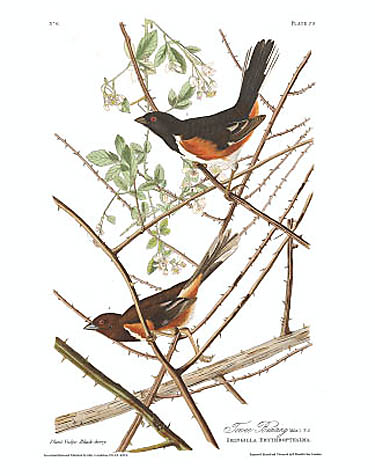|
Havell Name
Towee Bunting Common Name Eastern Towee Havell Plate No. 029 Paper Size 39" x 28" Image Size 19" x 11" Price $ 600 |
||||
|
Ornithological Biography The flight of the Towhe Bunting is short, low, and performed from one bush or spot to another, in a hurried manner, with repeated strong jerks of the tail, and such quick motions of the wings, that one may hear their sound, although the bird should happen to be out of sight. On the ground, where it is more usually to be seen, it hops lightly, without moving the tail more than the Common Sparrow of Europe. It is a diligent bird, spending its days in searching for food and gravel, amongst the dried leaves and in the earth, scratching with great assiduity, and every now and then uttering the notes towhee, from which it has obtained its name. At other times, it ascends to the top of a small tree, or its favourite low bushes and briars, on which it sings very sweetly a few continued mellow notes.
This species constructs a larger nest than birds of its size usually do, and scoops out a place for its foundation in the earth, sometimes in an open spot, more commonly at the foot of a small sapling or large bunch of tall grass. The nest is sunk into the ground, so as to be level with it at top, and is composed of dried leaves and the bark of vines, lined with grasses of fine texture, as well as fibrous roots. The female lays from four to six eggs, and rears two, sometimes three, broods each season. If disturbed while sitting, she moves off apparently in great agony, but with more celerity than most other birds, by which means she generally prevents her nest being discovered. Snakes, however, suck the eggs, as does the Crow. The young leave the nest long before they are able to fly, and follow the mother about on the ground for several days. Some of the nests of this species are so well concealed, that in order to discover them, one requires to stand quite still on the first appearance of the mother. I have myself several times had to regret not taking this precaution. The favourite haunts of the Towhe Buntings are dry barren tracts, but not, as others have said, low and swampy grounds, at least during the season of incubation. In the Barrens of Kentucky they are found in the greatest abundance. Their migrations are performed by day, from bush to bush, and they seem to be much at a loss when a large extent of forest is to be traversed by them. They perform these journeys almost singly. The females set out before the males in autumn, and the males before the females in spring, the latter not appearing in the Middle Districts until the end of April, a fortnight after the males have arrived. Many of them pass the confines of the United States in their migrations southward and northward. Although these birds are abundant in all parts of the Union, they never associate in flocks, but mingle during winter with several species of Sparrow. They generally rest on the ground at night, when many are caught by weasels and other small quadrupeds. None of them breed in Louisiana, nor indeed in the State of Mississippi, until they reach the open woods of the Choctaw Indian Nation. I have represented the male and female moving through the twigs of the common briar, usually called the black briar. It is a plump bird, and becomes very fat in winter, in consequence of which it is named Grasset in Louisiana, where many are shot for the table by the French planters. Male, 8 1/2, 12. Breeds from Texas along the Atlantic districts, as well as in the interior, northward to Labrador. Abundant. Migratory. |
|||||
|
|
|||||


| Home | Gallery | Audubon Biography | About Edition | Testimonials | Authorized Dealers | Links | Contact Us |

© Copyright 2007-2025 Zebra Publishing, LLC. | All Rights Reserved Terms of Use
Powered by Fusedog Media Group
